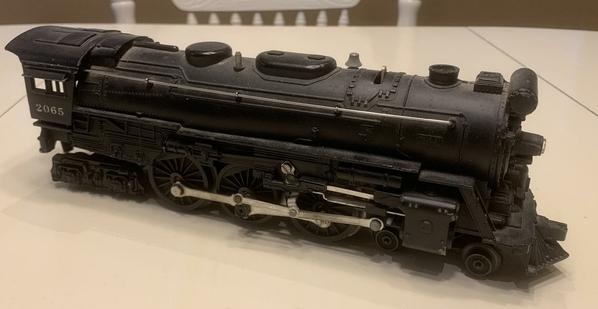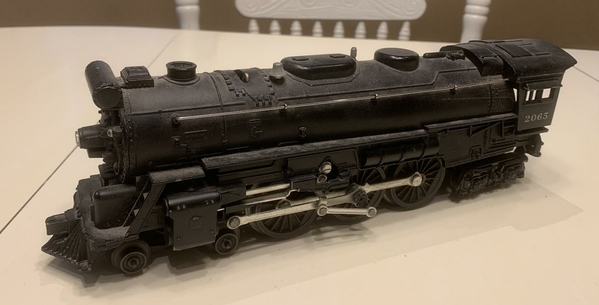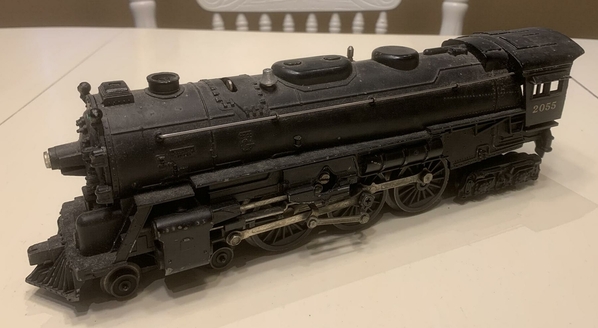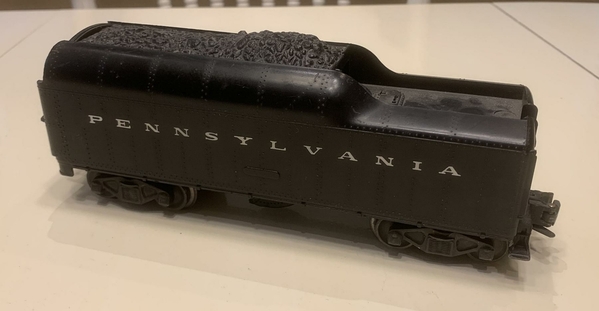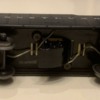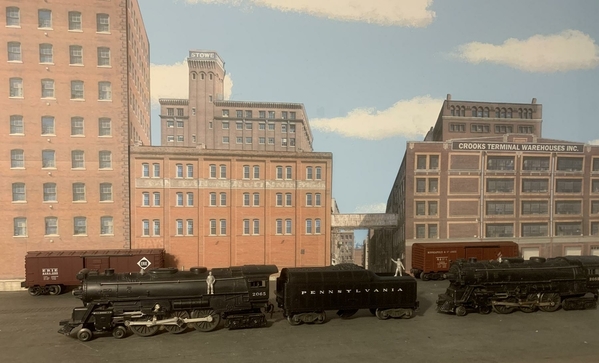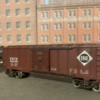Cont...
Okay... so I just got done with some 3-rail tinkering, and I'm in a gabby mood. SO, I'm going to breach a subject that is a love/hate relationship among 3-railers. Some of 'ya love it... some of 'ya don't. That subject is...
WEATHERING
In my past 3-rail excursions, weathering wasn't even considered. At the time, I sort of liked the "clean and pristine" look on my 3-rail stuff. In fact, I sought out such Postwar pieces. My longest term model railroad friend that I've been friends with since '69, also happens to like 3-rail. During my 3-rail years when we would go to train meets together (remember those?), he didn't mind one iota to purchase stuff that had lots of "play were" on the pieces. I didn't particularly care for such pieces. No, instead, during my 3-rail indulging that took place throughout most of the 1990s, I was more of a collector with a purpose: All engines had to have a KC connection. (Or could be generic, i.e. "Lionel Lines".) That was about it. I didn't have any pretensions of a permanent 3-rail layout, instead just satisfied to collect and run them on temporary layouts set up for that purpose. (And broke down and stored when not.)
Understand that my "nice and shiny" preference for my 3-rail was directly opposite of my scale modeling, where pretty much everything has to look used and "natural" looking. (Ever since I was a kid. For as a youngster, I would use talcum powder to add white streaking to some of my boxcars so they would look like some of the cars at yards in KC I would see with such an effect!) Essentially there's no exceptions: Everything is weathered, or will be. In fact, my efforts with my Kansas City & Gulf theme in "Wienie Scale" ( ) reflects a railroad running through the Ozarks in 1964 that has undergone bankruptcy and is now in the process of trying to reorganize. This "bankrupt" aspect was mainly incorporated so I could have plausibility for modeling many of engines in the aging KC&G diesel fleet as quite worn and tired. (I enjoy weathering effects.)
) reflects a railroad running through the Ozarks in 1964 that has undergone bankruptcy and is now in the process of trying to reorganize. This "bankrupt" aspect was mainly incorporated so I could have plausibility for modeling many of engines in the aging KC&G diesel fleet as quite worn and tired. (I enjoy weathering effects.)
Now here I am, seriously looking at a very real possibility of a 3-rail layout. And unlike my previous 3-rail experiments, this attempt has been given a lot more thought concerning my "Givens 'n Druthers" based on discoveries of 3-rail and me from my previous 3-rail attempts.
CLEAN SLATE
So, if you'll pardon the play on words, I have a "clean slate" as to how I will do 3-rail.
That means, seeing as I only have two pieces of rolling stock (both 6464 boxcars, one Postwar, and one "modern" release) the slate is pretty much clean as whether I will be okay with pieces that are very "play worn".
This much I know for a fact: When I mentally envision a future 3-rail layout, all the scenic elements (track, structures, etc) contain weathering. Everything. That so, I find that I now do not have a problem at all obtaining pieces that have lots of "play wear". (Scratches, fading, poor lettering, etc.) SO, that is "new" for me: I'm fine with play worn pieces. In fact, I think they look like "weathered" pieces and add character to each individual piece and, get this, they are can actually be preferred.
BUT...
Would I now go so far as to entertain the idea of actually applying weathering to some of the future pieces I will be purchasing?
Here it gets kind of weird. It's kind of a "yes and no" answer:
* Yes, I'm seriously considering adding some weathering to "new" pieces.
* No, I'm not wanting to weather them to the point they look like they're ready for the junk yard.
Instead of the junk yard modeling that I see so much in HO, what I will want is for the overall scene when viewing the layout to look "natural".
To do that, in view of my "Givens 'n Druthers", the equipment will need to look "less than" brand spanking new. (There can, and will be, exceptions. We'll get to that in a bit.) That is, when you look at a yard full of rolling stock on my 3-rail effort, I want the entire scene to reflect something similar to what you'd see in one of Jack Delano's color photos.
Now, if you're not familiar with the work of Jack Delano, and you would like to take a quick view of some of Jack Delano's railroad photos, hit the link below, and within a very few pictures, you'll have a couple scenes of urban rail yards:
https://www.theatlantic.com/ph...-yards-1940s/571924/
IF you have taken a look, then I'm sure you noticed one overriding tone: Grime. Perhaps you also noted there really weren't any "rust bucket" cars that grabbed your attention, instead, everything is grimy, not rust bucket. Why is that?
Simple: Steam power.
Steam power produced copious amounts of soot as well as cinders.
Why is this observation important?
Well, if you'll recall, I will be aiming at using traditional equipment to reflect the late-1940s/early-1950s. This is because my "Givens 'n Druthers" choices have influenced me to attempt portraying urban railroad scenes. (In my case, the KC area.) Now, if I want to reflect such scenes effectively in my modeling... then I'll need lots of grime.
That pretty much decides for me that if I want my future effort to evoke mental scenes such as are seen within Jack Delano's photos... I will need to grime things up. Not everything, mind you, but the overall tone when viewing my future 3-rail layout should reflect soot-covered equipment as well as on the nearby supporting cast (structures). Namely: Grime.
Yes, there will some exceptions to the "Grime With Time" rule. For example, rolling stock that is to reflect a relatively new car. Then there's the road diesels, many of those will just about be brand spankin' new, so those "almost new" diesel engines will get minimal grime.
That so...
Prior to this essay, I just spent about 30 minutes experimenting with this concept. I took one of my boxcars, the newest of the lot (a modern era 6464), and decided to try to add some grime, and make the car look a bit more "natural" and not like a brand spanking new car. Here's the car (right) sitting beside my Postwar M&StL 6464 just like it came out of the box:

Note how bright the white appears and its overall pristine condition. Also note that by virtue of its age, the M&StL 6464 is already looking pretty stinkin' good "as is"! Anyway, here's the same car with a bit of grime added:

And a down on look:

And an up close and personal look:

Yes, the differences are subtle. (When viewed in person, it is more readily discerned.)
Look at the rivet strips: See the shadow of "grime" along each one? Also note the roof has a subtle application of grime as well as the door and ends. Even the white of the "ERIE" herald has some grime applied to it in order to tone it down so it's not as startling. Grime is everywhere, but not heavily applied.
I've also added very slight touches of older rust (as opposed to newer rust, the two are different, with many shades in between) at select points along the floor rivets as well as touches under the door rails. Also note there's some older rust on the couplers and where the springs ride on the trucks. Seeing as these are plain bearing (commonly called "friction" bearings) trucks, then the cap areas and the wheels need to reflect being oily/greasy. (They were packed with "waste" and soaked in journal oil.)
SO, there you have it. I'm seriously considering this approach this time around. At this point, all of the above weathering is powdered chalk with no fixative applied. SO, should I decide against it, it can be wiped off and/or washed off (the plastic parts).
I'll leave it like it is for now, and give it the test of time, but I'm seriously leaning in this direction so the entire scene will look "natural" to my eyes.
Thoughts?
Oh, and what about engines? Same treatment?
Well now, that's an interesting question. I'll blather on about that in a future installment!
All fer now!
Andre




